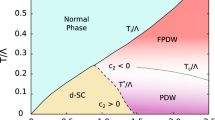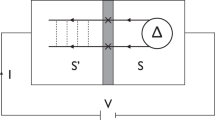Abstract.
In order to obtain information about the internal structure of fluctuating Cooper pairs in the pseudogap state and below the transition temperature of high Tc superconductors, we solve the Bethe-Salpeter equation for the two-electron propagator in order to calculate a “pair structure function” \(g_{P}({\mathbf{P}},\pmb{\rho})\) that depends on the internal distance \(\pmb{\rho}\) between the partners and on the center of mass momentum P of the pair. We use an attractive Hubbard model with a local potential for s-wave and a separable potential for d-wave symmetry. The amplitude of gP for small ρ depends on temperature, chemical potential and interaction symmetry, but the ρ dependence itself is rather insensitive to the interaction strength. Asymptotically gP decreases as an inverse power of ρ for weak coupling, but exponentially when a pseudogap develops for stronger interaction. Some possibilities of observing the pair structure experimentally are mentioned.
Similar content being viewed by others
References
T. Timusk, B. Statt, Rep. Prog. Phys. 62, 61 (1999)
M. Randeria, Proceedings of the International School of Physics “Enrico Fermi”, CXXXVI Course, Varenna (1997), arXiv:cond-Mat/9710223
Z.A. Xu, N.P. Ong, Y. Wang, T. Kakeshita, S. Uchida, Nature 406, 486 (2000); see also U. Thisted, J. Nyhus, T. Suzuki, J. Hori, K. Fossehim, arXiv:cond-mat/0304009
J.V. Emery, S.A. Kivelson, Nature 374, 434 (1998)
Q. Chen, I. Kosztin, B. Jankó, K. Levin, Phys. Rev. Lett. 81, 4708 (1998)
M. Fortes, M.A. Solís, M. de Llano, V.V. Tolmachev, Physica C 364–365, 95 (2001)
P. Noziéres, S. Schmitt-Rink, J. Low Temp. Phys. 59, 195 (1985)
Y.-J. Kao, A.P. Iyengar, Q. Chen, K. Levin, Phys. Rev. 64, 140505 (2001)
F. Pistolesi, G.C. Strinati, Phys. Rev. B 49, 6356 (1994)
L. Benfatto, A. Toschi, S. Caprara, C. Castellani, Phys. Rev. B 66, 054515 (2002)
R. Micnas, M.H. Pedersen, S. Schafroth, T. Schneider, J.J. Rodríguez-Núñez, H. Beck, Phys. Rev. B 52, 16223 (1995)
M. Yu. Kagan, R. Frésard, M. Capezzali, H. Beck, Phys. Rev. B 57, 5995 (1998)
J.M. Singer, M.H. Pedersen, T. Schneider, H. Beck, H.-G. Matuttis, Phys. Rev. B 54, 1286 (1996)
R. Micnas, J. Ranninger, S. Robaszkiewicz, Rev. Mod. Phys. 62, 113 (1990); T. Kostyrko, R. Micnas, Phys. Rev. B 46, 11025 (1992)
L.P. Kadanoff, G. Baym, Quantum Statistical Mechanics (New York, W.A. Benjamin Inc., 1962)
A. Sewer, H. Beck, Phys. Rev. B 64, 224524 (2001)
J.R. Engelbrecht, A. Nazarenko, M. Randeria, E. Dagotto, Phys. Rev. B 57, 13406 (1998)
N. Andrenacci, A. Perali, P. Pieri, G.C. Strinati, Phys. Rev. B 60, 12410 (1999)
See, for example: M. Greiner, O. Mandel, T. Esslinger, T.W. Hänsch, I. Bloch, Nature 415, 39 (2002); C. Orzel, A.K. Tuchman, M.L. Febnselau, M Yasuda, M.A. Kasevich, Science 291, 2386 (2001)
B. Paredes, J.I. Cirac, Phys. Rev. Lett. 90, 150402 (2003)
F. Pistolesi, G.C. Strinati, Phys. Rev. B 53, 15168 (1996)
D. Forster, Hydrodynamic Fluctuations, Broken Symmetry, and Correlation Functions (Benjamin, MA, 1975)
For a discussion on intrinsic vs. extrinsic pseudogap scenario, see, e.g., J. Stajic, A. Iyengar, K. Levin, B.R. Boyce, T.R. Lemberger, Phys. Rev. B 68, 0245020 (2003)
D. van der Marel, Optical signatures of electron correlations in the cuprates, Chapter in "Strong interactions in low dimensions", Series: Physics and Chemistry of Materials with Low-Dimensional Structures, Vol. 25, edited by D. Baeriswyl, L. Degiorgi (Kluwer, 2005), VI, ISBN: 1-4020-1798-7, cond-mat/0301506
A.A. Varlamov, G. Balestrino, E. Milani, D.V. Livanov, Adv. Phys. 48, 655 (1999)
A.A. Abrikosov, Fundamental of the Theory of Metals (Elsevier, Amsterdam, 1988), Chap. 17
G.-Q. Zheng, H. Ozaki, W.G. Clark, Y. Kitaoka, P. Kuhns, A.P. Reyes, W.G. Moulton, T. Kondo, Y. Shimakawa, Y. Kubo, Phys. Rev. Lett. 85, 405 (2000)
E. Altman, E. Demler, M.D. Lukin, Phys. Rev. A 70, 013603 (2004)
Author information
Authors and Affiliations
Corresponding author
Rights and permissions
About this article
Cite this article
Andrenacci, N., Capezzali, M. & Beck, H. Internal structure of fluctuating Cooper pairs. Eur. Phys. J. B 53, 417–432 (2006). https://doi.org/10.1140/epjb/e2006-00397-0
Received:
Published:
Issue Date:
DOI: https://doi.org/10.1140/epjb/e2006-00397-0




